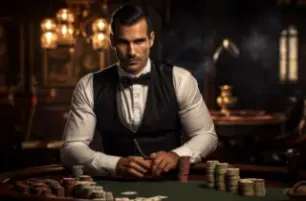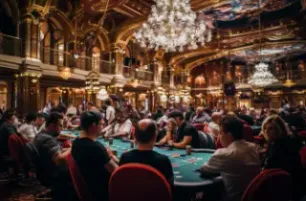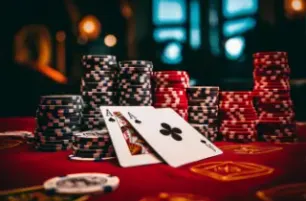From Classic to Creative: Blackjack Variations Unveiled
From classic variations like European Blackjack and Atlantic City Blackjack to innovative twists like Spanish 21 and Blackjack Switch, this article showcases each game's specific rules, deck configurations, and betting options.
Pontoon
Pontoon is a popular variation of blackjack with similarities to the traditional game but distinct rules that make it unique. In Pontoon, the objective remains the same—to get a hand value as close to 21 as possible without exceeding it. However, unlike traditional blackjack, the dealer's cards are facedown, providing an element of mystery. Additionally, the term "Pontoon" refers to a hand with an Ace and a 10-value card, which is the highest-ranking hand and pays out more than a regular blackjack. Players can also "buy" cards, similar to doubling down, but they can continue to do so up to a total of five cards. Pontoon offers an exciting twist to the classic blackjack game, making it a favorite among players seeking a fresh challenge.
Spanish 21
Spanish 21 is a popular blackjack variant that is played with a unique set of rules. In Spanish 21, all the 10-value cards are removed from the deck, leaving only the face cards and number cards. Despite the reduced number of cards, Spanish 21 still uses a standard 52-card deck. The removal of the 10-value cards increases the house edge, but to compensate for this, Spanish 21 offers a variety of favorable bonus payouts and special rules.
One of the key features of Spanish 21 is that players have the option to surrender after doubling down, which can help minimize potential losses in certain situations. Additionally, players can double down on any number of cards and can even double down after splitting pairs. Furthermore, a player's 21-point hand always wins, even if the dealer also has a 21.
Spanish 21 also offers exciting bonus payouts for specific hands, such as a 5-card hand totaling 21, a 6-card hand totaling 21, and a 7-card hand totaling 21. These bonus payouts can add an extra layer of excitement and potential winnings to the game.
Blackjack Switch
Blackjack Switch is an innovative and exciting blackjack variant that adds a unique twist to the traditional game. In this version, players are dealt two separate hands and have the option to switch the second card of each hand to create stronger combinations. This gives players a strategic advantage and increases the level of engagement and decision-making in the game.
The rules of Blackjack Switch include the dealer hitting on a soft 17 and the push rule, where the dealer's total of 22 results in a push instead of a bust. However, there is a caveat in this game: a dealer's total of 22 will beat any non-busted hand from the players, except for a player's natural blackjack. This rule slightly favors the house, but the ability to switch cards can still give skilled players an edge.
Switching cards allows players to create better hands, such as turning two weak hands into two strong hands, or splitting a pair of 10s to make two hands with a better chance of hitting 21. It introduces a whole new level of strategy as players must consider not only the individual hands they are dealt but also the potential for improvement through card switching.
Double Exposure Blackjack
Double Exposure Blackjack, also known as Face Up 21 or Dealer Disclosure, is a unique and intriguing variation of the classic blackjack game. In this variant, both of the dealer's cards are dealt face up, giving players valuable information about the dealer's hand from the very beginning.
The main difference in Double Exposure Blackjack lies in the advantage players gain by seeing both of the dealer's cards. However, to balance the game, certain rules are modified compared to traditional blackjack:
Natural Blackjack Pays Even Money: While getting a natural blackjack (an ace and a 10-value card) is usually paid at a higher rate (typically 3:2) in regular blackjack, in Double Exposure Blackjack, it pays even money. This rule reduces the advantage of seeing the dealer's face-up cards.
Dealer Wins Ties (Except for Natural Blackjack): In most blackjack variants, ties result in a push, but in Double Exposure Blackjack, the dealer wins all ties, except for ties on natural blackjacks. This rule further tips the odds slightly in the house's favor.
No Surrender Option: In Double Exposure Blackjack, the surrender option is usually not allowed. Players must play out their hands until the end.
The game's key attraction is the ability to make more informed decisions based on the knowledge of the dealer's cards. This aspect changes the standard blackjack strategy significantly, as players can accurately determine when to hit, stand, split, or double down based on the exposed dealer's hand.
Due to the altered rules and the advantage of seeing both dealer cards, Double Exposure Blackjack is generally considered to be more favorable to players compared to traditional blackjack. However, casinos may adjust certain rules or use multiple decks to maintain a reasonable house edge and ensure a fair gaming experience.
Blackjack Surrender
Blackjack Surrender is a popular blackjack variant that offers players the option to surrender their hand and receive back half of their original bet when they believe their chances of winning are low. This strategic option is not available in traditional blackjack and provides players with an opportunity to minimize potential losses in certain unfavorable situations.
The surrender option becomes available after the initial two cards are dealt to the player, but before they take any additional actions like hitting or standing. There are two types of surrender:
Early Surrender: In some variations of Blackjack Surrender, players can choose to surrender their hand immediately after receiving their initial two cards, even if the dealer has a potential blackjack. This is known as early surrender and offers the most favorable conditions for players.
Late Surrender: In other versions of Blackjack Surrender, players can only surrender their hand after the dealer checks for blackjack (a face-up ace or a 10-value card) and does not have a natural blackjack. This is known as late surrender and is slightly less advantageous for players.
The surrender option is valuable when a player's hand is weak (e.g., a hard 15 or 16) and the dealer's face-up card is strong (e.g., a 9, 10, or ace). In such situations, the probability of winning the hand is significantly reduced, and surrendering can be a prudent choice to cut potential losses.
It's important to note that using the surrender option strategically requires an understanding of basic blackjack strategy and knowing when surrendering is the most favorable move. While surrendering can be a useful tool to improve the player's overall odds, it should be used judiciously and in situations where it provides a clear advantage.
Blackjack Peek
Blackjack Peek is a variation of blackjack that is often found in European casinos. In this version, the dealer's second card (hole card) is dealt face down, and before players make any decisions on their hand, the dealer checks to see if they have a natural blackjack (an ace and a 10-value card). If the dealer has a blackjack, the round ends immediately, and all players lose their bets.
The peeking rule in Blackjack Peek provides players with some advantages and influences their strategy. Since the dealer checks for blackjack early in the game, players don't need to risk additional bets or make decisions on their hand if the dealer already has a winning hand. This can save players from making unnecessary moves and potentially losing more money.
However, if the dealer does not have a blackjack, the game continues as a standard blackjack round. Players can then proceed to make their decisions on hitting, standing, doubling down, or splitting based on their hand value and the dealer's visible card.
It's important to note that in Blackjack Peek, the dealer's peeking for blackjack only occurs when they have an ace or a 10-value card as their face-up card (usually a 10, jack, queen, or king). If the dealer has any other card, they do not peek, and the game follows the regular blackjack rules.
Blackjack Peek adds an element of excitement and anticipation to the game, as players eagerly wait to see if the dealer has a blackjack and whether they can proceed to play their hand. This variant provides an interesting twist to the classic blackjack gameplay and is favored by many players who enjoy the strategic elements and heightened suspense it offers.
Atlantic City Blackjack
Atlantic City Blackjack is a popular variation of the classic blackjack game that is commonly played in casinos, particularly in Atlantic City, New Jersey. It follows most of the standard blackjack rules, but there are some key differences that make it unique.
In Atlantic City Blackjack, the game is typically played with eight standard decks of 52 cards. One of the main distinguishing features of this variant is the option for late surrender. This means that players have the opportunity to surrender their hand and forfeit half of their bet after the dealer checks for blackjack. Late surrender allows players to minimize their losses in certain unfavorable situations.
Another important rule in Atlantic City Blackjack is that the dealer must stand on a soft 17. This means that if the dealer's hand consists of an ace and any other cards that add up to 17, they cannot hit and must stand. This rule slightly increases the players' chances of winning.
Furthermore, players can double down on any two initial cards and even after splitting pairs. This offers more opportunities for players to increase their bets and potentially win more.
Additionally, Atlantic City Blackjack allows players to split pairs up to three times, except for aces, which can only be split once. After splitting aces, players are usually allowed to receive only one additional card for each ace. Splitting pairs gives players a chance to create multiple hands and potentially improve their overall outcome.
European Blackjack
European Blackjack is a popular variant of the classic blackjack game that is commonly played in European casinos and online gambling platforms. It shares many similarities with the standard blackjack game but has a few distinct rules that set it apart.
One of the main differences in European Blackjack is the number of decks used. It is typically played with two standard decks of 52 cards, which is fewer than the decks used in American blackjack variants. The use of fewer decks can slightly affect the odds and strategy of the game.
In European Blackjack, the dealer is dealt only one face-up card at the beginning of the round. This means that the dealer does not receive a hole card, and they do not check for blackjack until after the players have completed their actions. As a result, players do not have to worry about the dealer having a natural blackjack and winning the round immediately.
Another key rule in European Blackjack is that the dealer must stand on all 17s, including soft 17s. This means that if the dealer's hand consists of an ace and any other cards that add up to 17, they must stand and cannot take any additional cards. This rule is favorable for players, as it reduces the chances of the dealer improving their hand and winning.
In terms of player options, European Blackjack follows the standard blackjack rules. Players can hit, stand, double down, and split pairs according to the standard strategy. They also have the option to take insurance if the dealer's face-up card is an ace.
Vegas Strip Blackjack
Vegas Strip Blackjack is a popular variation of the classic blackjack game that is commonly played in Las Vegas casinos and online gambling sites. It follows most of the standard blackjack rules but has a few distinct features that make it unique.
One of the main differences in Vegas Strip Blackjack is the number of decks used. It is typically played with four standard decks of 52 cards, which is common in many blackjack variants. The use of multiple decks can slightly affect the odds and strategy of the game.
In Vegas Strip Blackjack, the dealer is dealt two cards at the beginning of the round, one face-up and one face-down. This is a standard practice in most blackjack games. The dealer checks for blackjack if their face-up card is an ace or a ten-value card, giving players a chance to surrender or take insurance before continuing with their actions.
Like other blackjack variants, the goal in Vegas Strip Blackjack is to beat the dealer's hand without going over 21 points. Players have the option to hit, stand, double down, and split pairs according to the standard blackjack strategy. Additionally, players can also choose to surrender their hand, forfeiting half of their original bet, if they believe their chances of winning are low.
One notable feature of Vegas Strip Blackjack is that the dealer must stand on all 17s, including soft 17s. This means that if the dealer's hand consists of an ace and any other cards that add up to 17, they must stand and cannot take any additional cards. This rule benefits the players by reducing the chances of the dealer improving their hand and winning.




